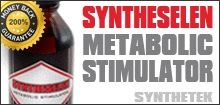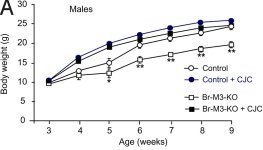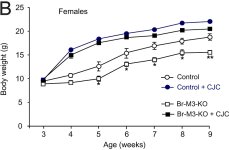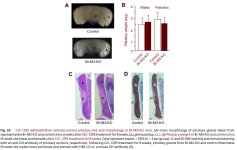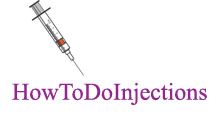Wise Guy said:
This is obviously a gross oversimplification of the process, which takes decades, but for time purposes (cut me slack, i'm studying for finals too here

) it will have to do.
Damn good post! I always need over simplification, just so I can make connections and start to get my head around something. It is like peeling an onion... so thank you for doing that and then pointing to a couple of things:
- One the estradiol levels in brain tissue. Dr. Crisler brought this up in regard to prostate health when I talked about my home brew DIM + formula for my 70 year old father.
I just noted it ...but now I want to focus on it some.
- Another, Leydig cell sensitivity... again an area I bump into and just kind of noted... but for some reason it always made me fear the use of HCG.
I have discovered that IGF-1, insulin and the GHRH/GHRPs on cycle seemed to do the same thing as HCG but especially in regard to the GHRPs I am now confused.
It seems Ghrelin is really involved in energy status feedback. In regard to the the HPT axis in most but not all instances it is a negative or inhibiting force. In other words, to over simplify, if energy status is low then fertility needs to go down... no need to reproduce if the body has other concerns.
Anyway a lot is still not understood, BUT my "perception" has been that GHRP-6 by itself even helps on a testosterone cycle. This counters what is known about Ghrelin but moves us into the most fascinating area and that is which neurons do the various GHS activate in the brain?
GHRP-6 activates neurons, but only 1/4th are related to signaling the hypothalamus to release of GHRH to the pituitary. The other 75% are other neurons...
...That is why if you mega-dose GHRP-6 in the milligram ranges you actually trigger release of somatostatin & reduce GHRH and end up inhibiting GH release.
Anyway I'm rambling as well...
The point is I still don't know why GHRP-6 is beneficial when the GHS-R on Leydig cells usually receives Ghrelin as a negative signal. Just a puzzle to me at the moment?????
Wise Guy said:
It is also specifically estriol which is a very important estrogen, especially as an anti aging, cancer protecting estrogen. It is a by-product of estradiol/estrone, a downstream metabolite of the two.
How do we measure estradiol levels in brain tissue?
Not only that, I am becoming more convinced by the day that serum markers for estrogen, especially in men, are wildly inaccurate. I really only trust the urinary analysis.
We now know that it is actually Leydig cell sensitivity which is a major reason, probably the biggest one, in why aging men lose testosterone.
The brain, as you have pointed out with GH, never loses its ability to secrete LH as well. Even in aging men, they still have the capability to secrete LH, a signal to tell your nads to start cranking out testosterone.
So just like the HTPA never loses its ability to secrete GH when given a proper signal to do so, it also never loses its ability to secrete LH.
The problem is the testes, specifically the leydig cells, become desensitized to the LH signal and lose the ability to make testosterone.
There are circulating hypothesis why, but I'm convinced it is a rather simple one - A combination of several factors, including inflammation, decreased insulin sensitivity and decreased GH levels, as well as rising cortisol, actually damage the leydig cells, further decreasing their ability to produce testosterone.
What I think usually happens is a combination of things, all starting to occur in the males early twenties. A drop off in GH production is usually the start of the process.
This leads to less restorative sleep, increased cortisol levels, and increased inflammation throughout the body. All leading to decreasing testosterone levels.
This is obviously a gross oversimplification of the process, which takes decades, but for time purposes (cut me slack, i'm studying for finals too here

) it will have to do.
Either way, my advice to men who want to stave off the loss of testosterone as they age and perhaps avoid TRT altogether until decades into the future, when things like SARM's and other methods of TRT will be in play, would be to
1. Stay active, keep inflammation to a minimum. This would include a low carb diet, good lifestyle and good sleep habits.
2. Maintain a healthy weight
3. Boost GH levels as soon as possible. The earlier you start, the better.
Ok enough rambling for now.
There is no need for me to comment on the above because I am just happy to read it. I even printed it out.

Leydig cell sensitivity... when I posted that study on Pulsation (the one where I posted a gif of somatotrophs self organizing to produce a pulse) I noted that the authors mentioned a study involving pulsing LH. The men who who were extremely deficient had packs strapped on that pulsed LH into them in a way that mimics nature. After several months they were restored.
I wonder... if pulsation in all forms (whether it is the pulsatile rhythm of insulin release or GH or LH) is a way to either resenstize or maintain senstivity in the receiving tissue.
Another area I have barely examined is the specific manner that receiving tissue signals the brain that it is okay, desensitized, hypersensitized, etc.
GHRP-6 (and I believe pulsing GHRH) has been shown to restore in older people, strong natural pulsation after 14 continuous days of use...which lasts for weeks beyond discontinuance. So when I travel now and I am without GHRH/GHRPs for several days I continue to experience the deep sleep...
What I am looking for is central themes, macro-explanations rather then microanalysis to help understand longevity and healthful restorations. The outer layer of the onion.
So we can say that the body primarily is a machine designed by evolution to maximize reproduction as this leads to the survival of the "selfish gene" (Thank you Mr. Dawkins). That is all it is...and the primary mechanisms in the body are redundant and often things are overdone in early life to maximize the potential for reproduction. Such things as turning off cells (cell cycle arrest) if there is only the slightest danger of DNA damage leading to something more catastrophic. Damn the consequences to the aging body because those bodies are of no value... they are not reproducers.
At the same time the body takes measure of energy balance in many ways (Leptin vs Ghrelin for instance). When energy balance is low for periods of time such as calorie restriction (i.e. 60% of lean maintenance) what happens?
In young and middle aged adults the body prolongs reproductive life... which prolongs lifespan. And it does this by [argue amongst yourselves].
I have to stop myself here because literally 100's of things are flying out of my head...possibilities...things to explore...etc.
But that is the point of doing macro-analysis... the type of stuff scientists laugh at... oversimplifications to the masses... but if they stopped for a moment to reframe things they study in very simple ways ...and forget for the moment that they are micro-experts, I believe they may achieve better understandings.
Now as I grab one of those ideas flying from my head, I wonder does calorie restriction or alternate day fasting increase leydig cell sensitivity? I need to look into it...
I so hesitate to draw conclusions from my own "unmeasured" subjective short-term sample of one "biased toward hopeful" experiment. But I have been alternate day fasting for about a month now and I have noticed signs of something like that going on following the 3rd week of this experiment (the point where alternate day fasting pushed biomarkers to the same level as every day calorie restriction).
Okay...I apologize for overlaying my musings on your very beautiful post. Thanks again for taking the time to have made it...
...now go study stuff so you can regurgitate it.

















